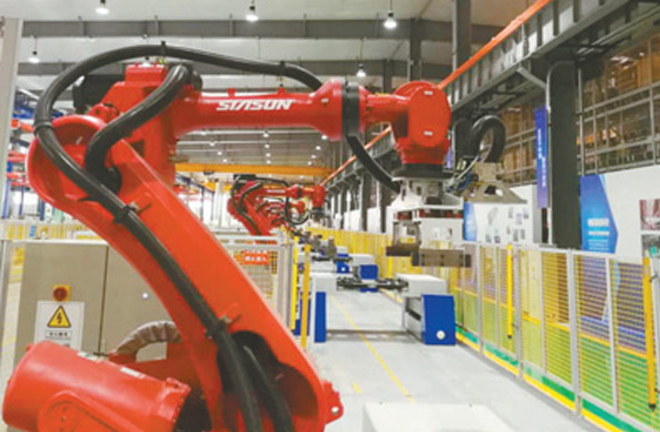Developing a modern economic system in northeast China

Pictured above is a robot automatic production workshop at SIASUN Robot and Automation in Shenyang, capital city of Northeast China’s Liaoning Province. The city is facilitating high-quality development to become an international and modern metropolis.(PEOPLE’S DAILY)
On June 10, the symposium titled Innovation and Entrepreneurship, Revitalization and Modern Economic System of Northeast China was held at Liaoning University in Liaoning Province of Northeast China. Experts from the Chinese Academy of Social Sciences, Chinese Academy of Sciences, Liaoning University, and other research institutions and universities discussed developing a modern economic system in Northeast China.
Huang Qunhui, director of the Institute of Industrial Economics at the Chinese Academy of Social Sciences, said that in order to develop a modern economic system, the key is building a modern power, industry and regional system.
Wang Weiguang, dean of the Asia-Australia Business College of Liaoning University, said that the effective operation of a modern economic system needs to be driven by innovation. Since innovation paths are dependent on distinct regional conditions, developing such a system must consider locality and highlight local features.
Hu Dengfeng, vice dean of the School of Business Administration at Anhui University of Finance and Economics, said that resource endowments and market forces determine paths for innovation and industrial upgrading. When formulating policies, the government needs to consider regional differences. In the long run, the direction of industrial upgrading is technological innovation.
Innovation is the primary driving force for growth. Xu Heping, former director of the Research Department of the Ministry of Science and Technology proposed three ways to promote innovation and transformation in Northeast China. First, pursue innovation by surpassing the traditional framework and exploring new business models. Second, promote the coordinated development of the real economy, scientific and technological innovation, modern finance and human resources; as well as the deep integration of the Internet, big data, artificial intelligence and the real economy. Third, promote the green and intelligent transformation of industry to help new technologies, industries and business models grow rapidly.
Jin Fengjun, a research fellow at the Institute of Geographic Sciences and Natural Resources Research at the Chinese Academy of Sciences, said that to boost economic growth in Northeast China, it is necessary to cultivate new growth drivers by optimizing the allocation of resources like labor and reshape old industrial bases by adjusting the organizational, industrial and spatial structure. Also, the “development zones” in Northeast China are not contributing to growth as much as expected. It is desirable for Northeast China to learn from typical practices of other regions, such as the Chongqing Liangjiang New Area, to create a competitive regional industrial system.
An important way to revitalize Northeast China is to integrate it into the China-Mongolia-Russia Economic Corridor, a Belt and Road project. Li Xihui, dean of the School of Management at Minzu University of China, proposed a number of measures like boosting border trade and improving residents’ lives by increasing jobs, developing industries and improving international law enforcement in border areas.
Li also recommended streamlining administration and delegating power by facilitating trade, investment, personal exchange and transportation. In addition, Li called for adjustments to trade structure by promoting trade in services and border trade as well as promoting border tourism.
(edited by YU HUI)
